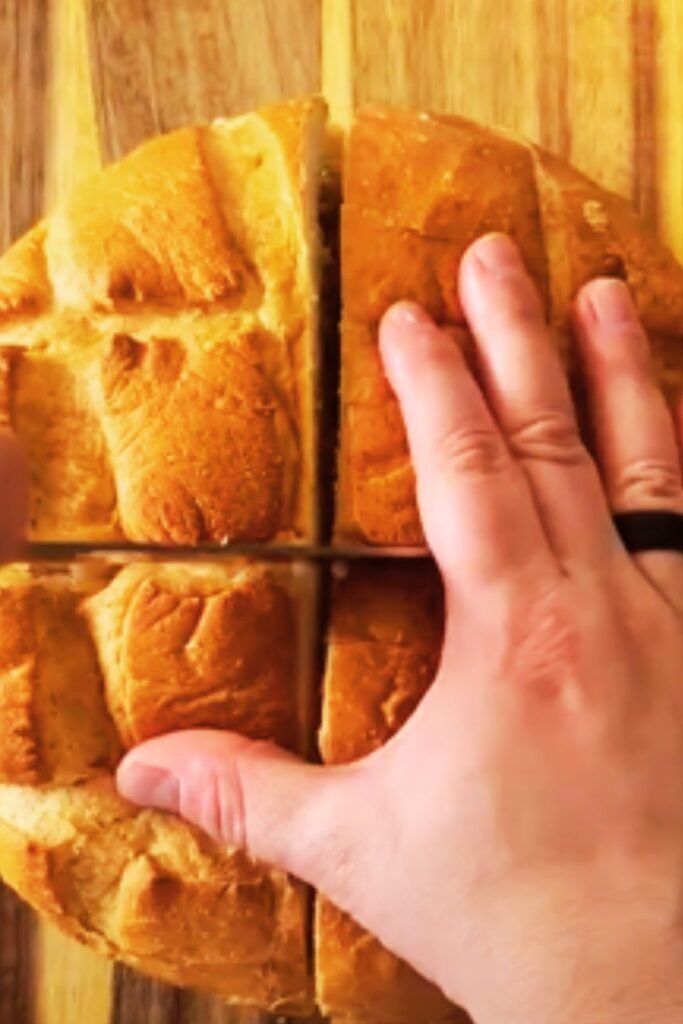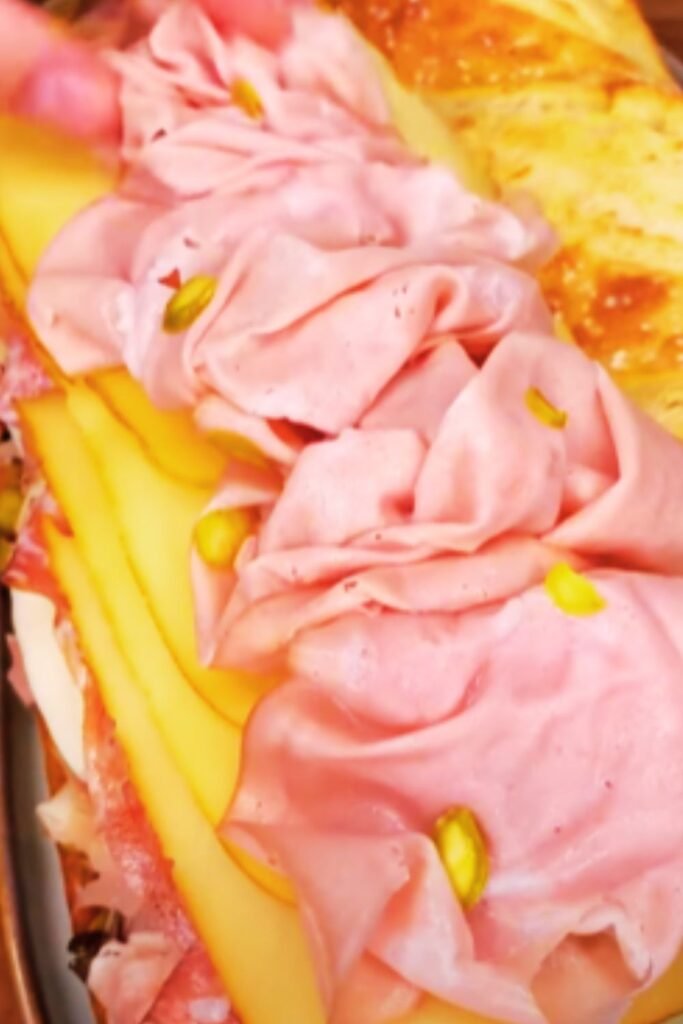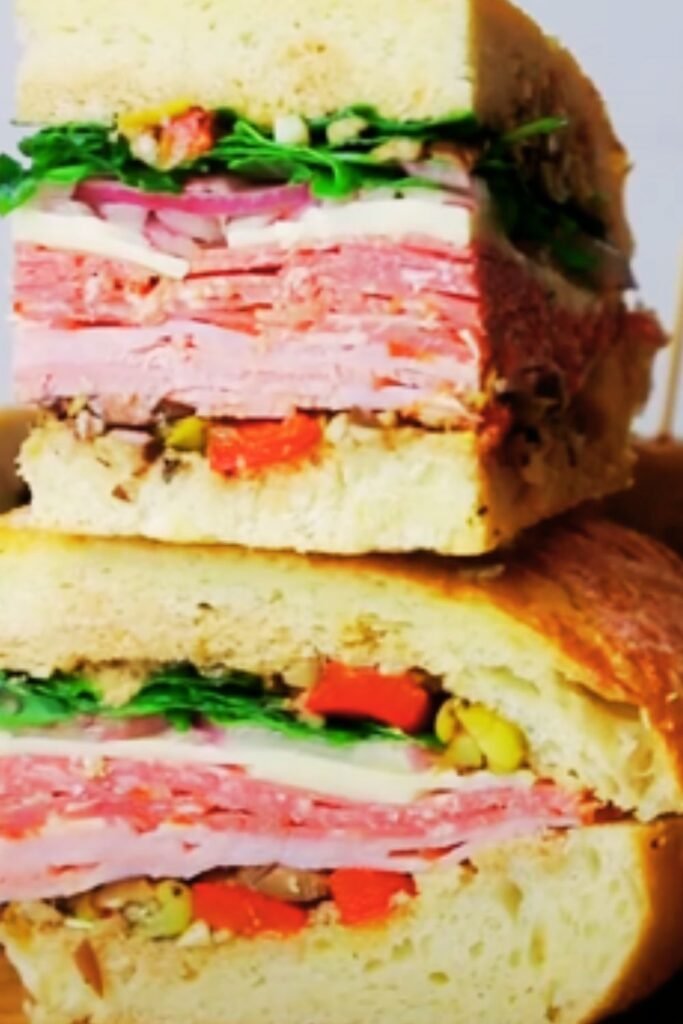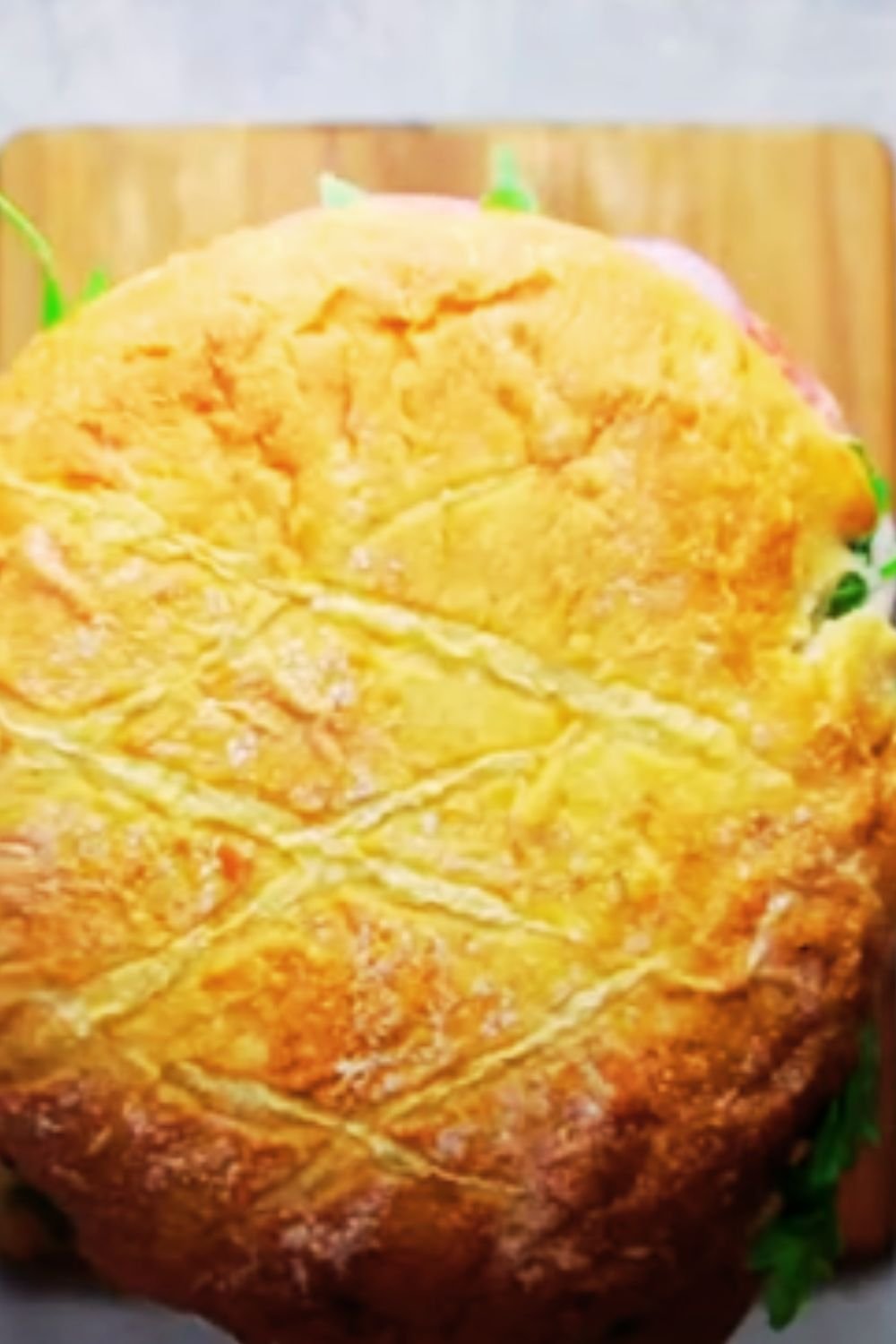I still remember my first bite of an authentic Muffuletta sandwich at Central Grocery in New Orleans’ French Quarter. The explosion of flavors – tangy olives, salty cured meats, creamy cheeses, all nestled in that distinctive sesame-studded bread – was nothing short of revelatory. This wasn’t just another sandwich; it was a piece of culinary history that transported me straight to the heart of Louisiana’s Italian-American community.
The Muffuletta represents more than sustenance. It embodies the story of Italian immigrants who arrived in New Orleans in the late 19th and early 20th centuries, bringing their traditions and adapting them to local ingredients and tastes. What emerged was a sandwich that perfectly captures the essence of both old-world Sicily and vibrant New Orleans culture.
Understanding the Muffuletta: Key Components Defined
Muffuletta Bread : A round, flat Sicilian sesame bread, typically 8-10 inches in diameter, with a sturdy crust that can hold substantial fillings without becoming soggy
Olive Salad (Giardiniera) : The signature condiment made from chopped olives, celery, cauliflower, carrots, and various vegetables marinated in olive oil, vinegar, and herbs
Mortadella : A finely ground Italian cold cut made from pork, often studded with pistachios or peppercorns
Capicola : A traditional Italian cured meat made from pork shoulder or neck, seasoned with wine and various spices
Genoa Salami : A hard, dry-cured sausage originating from Genoa, Italy, made from pork and beef with wine and garlic
Provolone Cheese : A semi-hard Italian cheese with a mild, slightly sharp flavor that melts beautifully
The Rich History Behind This Iconic Sandwich
The Muffuletta’s origin story begins in 1906 when Salvatore Lupo, a Sicilian immigrant, opened Central Grocery & Deli in New Orleans’ French Quarter. Lupo noticed that Sicilian workers would purchase separate ingredients – bread, cold cuts, cheese, and his famous olive salad – then struggle to eat them together while working.
Being the innovative businessman he was, Lupo decided to combine all these elements into one convenient, portable meal. He took the traditional Sicilian muffuletta bread, split it horizontally, and layered it with the olive salad, various Italian meats, and cheese. The result was revolutionary – a sandwich that could feed multiple people and actually improved in flavor as the olive oil and juices soaked into the bread.
What makes this story particularly fascinating is how the Muffuletta reflects the broader narrative of Italian immigration to New Orleans. Unlike other American cities where Italian immigrants often faced discrimination, New Orleans embraced these newcomers, partly because the city already had a strong Catholic, Mediterranean-influenced culture from its French and Spanish colonial periods.

Essential Ingredients and Quality Specifications
Creating an authentic Muffuletta requires attention to ingredient quality and proportions. I’ve spent years perfecting this recipe, and I can tell you that shortcuts simply don’t work with this sandwich.
Bread Requirements
The foundation of any great Muffuletta is the bread. You need a sturdy, round Sicilian bread that’s approximately 10 inches in diameter. The crust should be firm enough to contain the generous fillings without becoming soggy, while the interior should be slightly dense with a fine crumb structure.
If you can’t find authentic muffuletta bread, a good Italian round bread or even a large focaccia can work as substitutes, though the flavor profile will differ slightly.
Meat Selection and Proportions
| Meat Type | Weight (oz) | Thickness | Key Characteristics |
|---|---|---|---|
| Mortadella | 4-6 | 1/8 inch | Smooth texture, mild flavor |
| Genoa Salami | 4-6 | 1/8 inch | Firm texture, garlicky taste |
| Capicola | 3-4 | 1/8 inch | Slightly spicy, wine-cured |
| Ham (optional) | 2-3 | 1/8 inch | Adds sweetness, not traditional |
Cheese Selection
Provolone remains the traditional choice, but I’ve found that a combination works exceptionally well:
- 6 oz sliced provolone (mild or sharp)
- 2 oz mozzarella for creaminess
- 1 oz Romano for additional sharpness
The Star: Olive Salad Composition
The olive salad is where the magic happens. This isn’t just chopped olives; it’s a complex medley of vegetables and seasonings that creates the Muffuletta’s distinctive flavor profile.
| Ingredient | Amount | Preparation | Purpose |
|---|---|---|---|
| Green olives | 1 cup | Coarsely chopped | Briny base flavor |
| Kalamata olives | 1/2 cup | Coarsely chopped | Rich, fruity notes |
| Celery | 1/2 cup | Finely diced | Crunch and freshness |
| Cauliflower | 1/3 cup | Small florets | Texture and mild flavor |
| Carrots | 1/4 cup | Finely diced | Sweetness and color |
| Red bell pepper | 1/4 cup | Diced | Sweetness and crunch |
| Garlic | 3 cloves | Minced | Aromatic base |
| Oregano | 1 tbsp | Dried | Traditional Italian herb |
| Red pepper flakes | 1/2 tsp | Crushed | Heat and complexity |
| Red wine vinegar | 2 tbsp | – | Acidity and preservation |
| Extra virgin olive oil | 1/3 cup | – | Richness and binding |

Mastering the Olive Salad: The Heart of the Muffuletta
Creating exceptional olive salad requires patience and technique. I recommend making it at least 24 hours before assembling your sandwich, though it actually improves over several days.
Begin by draining your olives thoroughly. I pat them dry with paper towels to remove excess brine, which can make the salad too salty. Chop the olives coarsely – you want distinct pieces, not a paste.
For the vegetables, uniform sizing is crucial. I dice the celery and carrots into roughly 1/4-inch pieces, while the cauliflower should be broken into small, bite-sized florets. The red bell pepper adds both sweetness and visual appeal, so don’t skip it even if it’s not in every traditional recipe.
The seasoning blend is where you can adjust to your taste preferences. I prefer a generous hand with oregano and a moderate amount of red pepper flakes. The garlic should be minced fine enough to distribute evenly but not so fine that it disappears.
When combining ingredients, start with the vegetables and herbs, then slowly drizzle in the olive oil while stirring. The vinegar comes last – it helps brighten all the flavors and acts as a natural preservative.
Step-by-Step Assembly Technique
Assembling a Muffuletta is an art form that I’ve refined through countless attempts. The key is layering and proportion.
Preparation Phase:
- Remove bread from refrigerator 30 minutes before assembly
- Bring olive salad to room temperature
- Arrange all meats and cheeses on a large cutting board
Assembly Process:
- Bread Preparation: Slice the muffuletta bread horizontally, creating top and bottom halves of equal thickness. If the bread seems too thick, you can remove some of the interior crumb, but leave enough structure to support the fillings.
- Initial Olive Salad Layer: Spread approximately 1/3 of your olive salad on the bottom half of the bread. This creates a moisture barrier and ensures every bite has that signature flavor.
- First Cheese Layer: Place half of your provolone directly on the olive salad. This helps bind the ingredients and prevents the meats from sliding.
- Meat Layering: Begin with mortadella, laying slices so they slightly overlap. Follow with salami, then capicola. The key is creating even coverage without overpacking.
- Second Cheese Layer: Add the remaining provolone and any other cheeses you’re using.
- Final Olive Salad: Spread the remaining olive salad on the top half of the bread. This ensures flavor distribution throughout the sandwich.
- Compression: Place the top on the sandwich and press down firmly but gently. The goal is to compact the ingredients without squeezing out the olive oil.

The Critical Resting Period: Why Patience Pays
Here’s where many home cooks go wrong – they want to eat their Muffuletta immediately. I understand the temptation, but patience is essential for achieving authentic flavors and texture.
After assembly, wrap your Muffuletta tightly in plastic wrap or aluminum foil. The wrapping should be snug enough to maintain compression without crushing the sandwich. Place it in the refrigerator for a minimum of 2 hours, though I recommend 4-6 hours for optimal results.
During this resting period, several important things happen:
- The olive oil penetrates the bread, creating the signature flavor
- Flavors meld and intensify
- The bread softens slightly while maintaining structure
- Juices redistribute evenly throughout the sandwich
Some purists argue for longer resting periods – up to 24 hours. While this can deepen flavors, I find that overly long resting can sometimes make the bread too soft, losing some of the textural contrast that makes a great Muffuletta special.
Serving and Presentation Guidelines
A traditional Muffuletta serves 2-4 people, depending on appetites and what else you’re serving. I typically cut mine into quarters using a sharp, serrated knife. The key is making confident, decisive cuts without sawing back and forth, which can displace the carefully layered ingredients.
Serving Temperature Options:
- Room Temperature: Traditional and preferred method
- Slightly Chilled: Acceptable, especially in hot weather
- Lightly Warmed: Controversial but increasingly popular
If you choose to warm your Muffuletta, wrap individual portions in foil and heat in a 350°F oven for 8-10 minutes. This melts the cheese slightly and brings out the aromatic herbs, though it changes the traditional texture profile.
Regional Variations and Modern Adaptations
While purists insist on the traditional recipe, I’ve encountered fascinating regional variations throughout Louisiana and beyond.
New Orleans Variations:
- Some establishments add a thin layer of butter to the bread
- Certain shops include roasted red peppers in their olive salad
- A few places use a mixture of Italian bread types
Modern Adaptations:
- Vegetarian versions using grilled vegetables and additional cheeses
- Seafood variations incorporating Gulf shrimp or crabmeat
- Smaller, individual-sized versions for parties
Regional American Interpretations:
- West Coast versions often include avocado
- Midwest adaptations sometimes feature local sausages
- East Coast variations might include additional Italian cold cuts
Nutritional Profile and Dietary Considerations
Understanding the nutritional aspects of a Muffuletta helps you incorporate it thoughtfully into your meal planning.
| Nutritional Component | Per Quarter Sandwich | Daily Value % |
|---|---|---|
| Calories | 680-720 | 34-36% |
| Total Fat | 42-48g | 65-74% |
| Saturated Fat | 16-18g | 80-90% |
| Sodium | 1,800-2,200mg | 78-96% |
| Carbohydrates | 48-52g | 16-17% |
| Protein | 28-32g | 56-64% |
| Fiber | 3-4g | 12-16% |
The high sodium content reflects the cured meats, cheese, and olive salad. If you’re watching sodium intake, you can reduce it by:
- Using lower-sodium versions of meats and cheese
- Rinsing olives before chopping
- Reducing the amount of olive salad
For those with dietary restrictions, several modifications work well:
- Gluten-free: Use certified gluten-free bread
- Lower-fat: Reduce meat portions and use part-skim cheeses
- Vegetarian: Replace meats with grilled vegetables and additional cheeses
Storage, Make-Ahead Tips, and Food Safety
Proper storage extends the life of both your olive salad and assembled sandwiches.
Olive Salad Storage:
- Refrigerate in airtight containers for up to 2 weeks
- Always use clean utensils to prevent contamination
- The flavor actually improves over the first few days
Assembled Sandwich Storage:
- Best consumed within 24 hours of assembly
- Keep refrigerated until 30 minutes before serving
- Can be frozen for up to 1 month, though texture changes slightly
Food Safety Considerations:
- Never leave assembled sandwiches at room temperature for more than 2 hours
- Use fresh, high-quality meats and cheeses
- Ensure olive salad ingredients are properly cleaned
Troubleshooting Common Muffuletta Problems
Through years of making and teaching others to make Muffulettas, I’ve identified the most common issues and their solutions.
Soggy Bread Problem:
- Cause: Too much olive salad or insufficient resting time
- Solution: Use less olive salad initially, ensure proper compression during resting
Bland Flavor:
- Cause: Insufficient olive salad or poor-quality ingredients
- Solution: Increase olive salad quantity, use high-quality Italian meats
Falling Apart:
- Cause: Bread too soft, improper cutting technique
- Solution: Use firmer bread, make decisive cuts with sharp knife
Uneven Flavor Distribution:
- Cause: Poor layering technique
- Solution: Ensure olive salad on both bread halves, even meat distribution
Pairing Suggestions and Complementary Sides
A Muffuletta is substantial enough to be a complete meal, but certain accompaniments enhance the experience.
Traditional Accompaniments:
- Crisp dill pickles
- Kettle-cooked potato chips
- Fresh fruit salad
- Simple green salad with vinaigrette
Beverage Pairings:
- Italian sodas (orange, lemon, or cherry)
- Iced sweet tea (Southern tradition)
- Sparkling water with lemon
- Italian espresso or strong coffee
Complementary Flavors:
- Antipasto salad
- Marinated vegetable salad
- Fresh mozzarella and tomato caprese
- Cannoli or tiramisu for dessert
Questions and Answers
Q: Can I make the olive salad ahead of time? Yes, and I actually recommend it! The olive salad improves significantly when made 24-48 hours before using. The flavors meld together beautifully, and the vegetables absorb the olive oil and seasonings. Store it covered in the refrigerator for up to two weeks.
Q: What’s the best substitute if I can’t find muffuletta bread? A sturdy Italian round bread or focaccia works well as a substitute. Look for bread that’s about 8-10 inches in diameter with a firm crust. Some people use large Kaiser rolls, but you’ll need to adjust the proportions accordingly.
Q: Should I heat my Muffuletta before serving? Traditionally, Muffulettas are served at room temperature or slightly cool. However, some people prefer them lightly warmed, which melts the cheese and brings out the aromatic herbs. If you choose to warm it, wrap in foil and heat at 350°F for 8-10 minutes.
Q: How long should I let the sandwich rest before eating? I recommend a minimum of 2 hours, with 4-6 hours being ideal. This resting period allows the olive oil to penetrate the bread and the flavors to meld together. Some people let it rest overnight, but I find this can sometimes make the bread too soft.
Q: Can I make a vegetarian version of a Muffuletta? Absolutely! Replace the meats with grilled vegetables like eggplant, zucchini, and roasted red peppers. You can also add more cheese varieties or include marinated artichoke hearts. The key is maintaining the substantial, satisfying nature of the original.
Q: Why is my olive salad too salty? This usually happens when the olives aren’t drained and patted dry before chopping, or when too much olive brine gets incorporated. Always drain olives thoroughly and pat them dry. You can also rinse them briefly if they seem overly salty.
Q: How many people does one Muffuletta serve? A traditional 10-inch Muffuletta typically serves 2-4 people, depending on appetites and what else you’re serving. I usually cut it into quarters for serving, making it perfect for sharing as a lunch or casual dinner.
Q: Can I freeze a Muffuletta? Yes, you can freeze assembled Muffulettas for up to one month. Wrap them tightly in plastic wrap and aluminum foil. However, the texture will change slightly upon thawing – the bread may become a bit softer and the vegetables in the olive salad might lose some crispness.
Q: What’s the difference between a Muffuletta and other Italian sandwiches? The Muffuletta is unique because of its distinctive olive salad, the specific combination of Italian meats, and the traditional round Sicilian bread. Unlike other Italian sandwiches that might focus on one or two ingredients, the Muffuletta is about the harmony of multiple components working together.
Q: How do I prevent my Muffuletta from falling apart when I cut it? Use a sharp, serrated knife and make confident, decisive cuts without sawing back and forth. Make sure the sandwich has rested properly so the ingredients have settled. Some people like to secure each quarter with a toothpick before serving.
The Muffuletta stands as a testament to the beautiful fusion of cultures that makes New Orleans cuisine so extraordinary. When I bite into a perfectly crafted Muffuletta, I taste not just the wonderful combination of meats, cheese, and that incredible olive salad, but also the story of Italian immigrants who found a new home and created something uniquely American while honoring their heritage.
Making an authentic Muffuletta requires patience, quality ingredients, and respect for tradition. But the reward – that perfect balance of flavors and textures, the way the olive oil soaks into the bread, the satisfying heft of a properly constructed sandwich – makes every step worthwhile. Whether you’re recreating a memory of New Orleans or discovering this classic for the first time, the Muffuletta offers a delicious journey into American culinary history.


